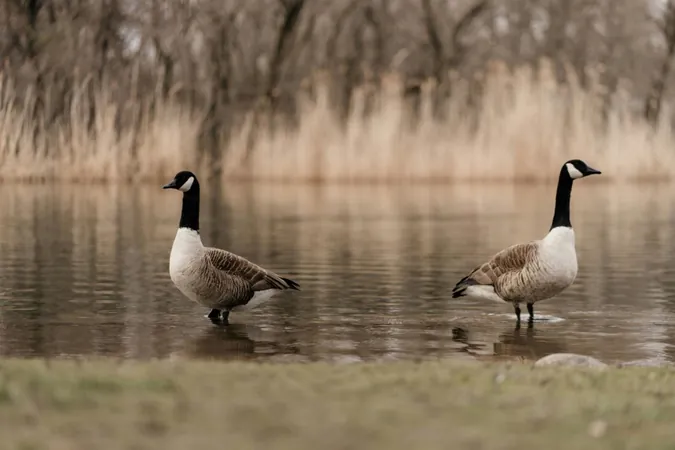
Warning for Spring Migrants: Bird Flu Threat Looms Over Northern Ontario
2025-04-05
Author: Olivia
Warning for Spring Migrants: Bird Flu Threat Looms Over Northern Ontario
As the vibrant spring migration season ushers in thousands of birds back to Northern Ontario, a looming threat has surfaced—avian influenza, commonly referred to as bird flu. With the return of these migratory birds, health and safety are at the forefront of concerns among local communities, particularly for hunters.
Lawrence Martin, the director of the lands and resources department at Mushkegowuk Council, is calling for heightened awareness among hunters as they gear up for geese and ducks hunting this season. Growing up near Moose Factory, Martin noted that bird populations often cycle through periods of disease, especially when numbers swell. “Every time there's a huge population of ducks, there would be birds that seem sick,” he remarked, echoing wisdom passed down from elders concerning the cyclical nature of wildlife viruses.
While bird flu outbreaks are not a novel occurrence, the current strain—H5N1—has raised alarms due to its significant impacts on domestic poultry. The poultry industry has already felt the repercussions of this highly pathogenic strain, leading to distressing egg shortages and economic losses for farmers.
In light of these developments, Martin advises hunters to be vigilant for any signs of illness in birds, particularly noting unusual behaviors as indicators of poor health. “Healthy birds stay away, but sick ones may come right to you more quickly. If you see a goose that seems wounded or is alone, there’s something wrong,” he cautioned.
Mushkegowuk Council has issued comprehensive guidelines to mitigate the risk of exposure to avian influenza: - Avoid hunting in areas with reported outbreaks or where dead birds are visible. - Refrain from handling or consuming sick birds. - Utilize gloves during any handling of birds and avoid contact with blood, feces, or respiratory secretions. - Ensure to wash hands thoroughly after handling birds; if soap and water aren’t readily available, use a hand sanitizer with at least 60% alcohol. - Keep pets away from sick or dead birds. - Clean and disinfect all tools, surfaces, and clothing after any interaction with birds.
The responsibility for managing bird flu outbreaks predominantly lies with government bodies, including the Ontario Ministry of Natural Resources and Forestry (MNRF). In communications with local media, MNR spokesperson Mike Fenn confirmed that cases of highly pathogenic avian influenza have been reported across Ontario and North America since 2022, with expectations for ongoing detections in the upcoming years, especially during migration seasons.
While there are no current plans for local or regional testing by the MNRF, Fenn noted, “A lot of the issues seem to be still to the south of us, but it could spread.” MNRF collaborates with a variety of agencies through the Ontario HPAI One Health team to monitor and address the situation, which includes wildlife surveillance not only for birds but also for mammals like foxes, raccoons, and skunks, in an effort to gauge the virus's spread.
With millions of birds migrating from Central America through Ontario to Hudson Bay, the need for careful monitoring is paramount. Martin stressed, “We have to be really cautious.” He encourage community members to report any suspected cases of avian influenza to the Canadian Wildlife Health Cooperative at 1-866-673-4781 or through their online reporting service.
As both bird migrations peak and hunting season begins, Martin’s message resonates louder than ever: “Be careful out there. Take the necessary precautions—not just for our food, but for our safety.” In a time when wildlife and human health are intertwined, vigilance is critical as nature’s return brings not only beauty but potential risk.









 Brasil (PT)
Brasil (PT)
 Canada (EN)
Canada (EN)
 Chile (ES)
Chile (ES)
 Česko (CS)
Česko (CS)
 대한민국 (KO)
대한민국 (KO)
 España (ES)
España (ES)
 France (FR)
France (FR)
 Hong Kong (EN)
Hong Kong (EN)
 Italia (IT)
Italia (IT)
 日本 (JA)
日本 (JA)
 Magyarország (HU)
Magyarország (HU)
 Norge (NO)
Norge (NO)
 Polska (PL)
Polska (PL)
 Schweiz (DE)
Schweiz (DE)
 Singapore (EN)
Singapore (EN)
 Sverige (SV)
Sverige (SV)
 Suomi (FI)
Suomi (FI)
 Türkiye (TR)
Türkiye (TR)
 الإمارات العربية المتحدة (AR)
الإمارات العربية المتحدة (AR)